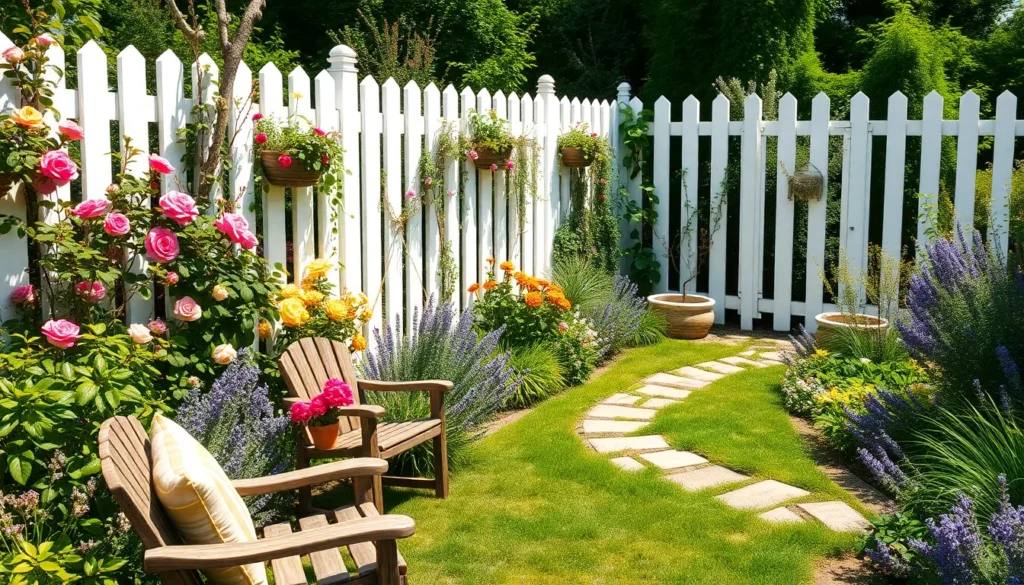We’ve all dreamed of having our own private garden sanctuary – a peaceful retreat where we can escape the chaos of daily life and reconnect with nature. An enclosed garden transforms any outdoor space into an intimate haven that’s completely yours to enjoy.
Whether you’re dealing with nosy neighbors curious eyes or simply want to create a more intimate atmosphere your backyard can become the perfect secluded oasis. From modern privacy screens to charming cottage-style fencing there are countless ways to enclose your garden while adding both function and beauty to your outdoor space.
The best part? You don’t need a massive budget or extensive landscaping experience to create your dream enclosed garden. With the right design ideas and a bit of creativity we’ll show you how to transform your outdoor area into a private paradise that reflects your personal style and meets your exact needs.
Create a Private Oasis With High Fence Panels
High fence panels transform any outdoor space into a secluded retreat where privacy meets style. We’ll explore how to maximize your enclosed garden’s potential with strategic material choices and decorative enhancements.
Choose Weather-Resistant Materials
Composite fencing offers the perfect blend of durability and low maintenance for your enclosed garden sanctuary. These panels withstand harsh weather conditions while maintaining their appearance for decades without warping, rotting, or fading.
Cedar panels provide natural beauty and excellent weather resistance at a moderate price point. Cedar’s natural oils repel insects and moisture, making it an ideal choice for creating long-lasting privacy barriers.
Vinyl fencing delivers superior weather protection with minimal upkeep requirements. This material resists moisture, UV rays, and temperature fluctuations while offering clean lines that complement modern garden designs.
Aluminum panels combine strength with corrosion resistance for areas with high humidity or coastal conditions. These lightweight options install easily and provide decades of reliable privacy without rusting or deteriorating.
Incorporate Decorative Elements
Geometric cutouts add visual interest while maintaining privacy in your enclosed garden space. These patterns create shadows and light play throughout the day, improving the overall aesthetic appeal of your private oasis.
Horizontal slat designs offer a contemporary look that makes spaces appear larger and more open. We recommend varying slat widths to create ever-changing visual rhythm along your fence line.
Mixed material panels combine wood, metal, or stone elements to create unique focal points. This approach allows you to match existing architectural features while adding personality to your garden enclosure.
Decorative post caps and hardware details elevate simple fence panels into sophisticated design elements. Choose materials that complement your home’s exterior for a cohesive outdoor living space.
Add Climbing Plants for Natural Beauty
Evergreen vines like ivy or jasmine provide year round coverage and privacy enhancement for your fence panels. These plants create living walls that soften hard edges while maintaining dense screening.
Flowering climbers such as clematis or climbing roses add seasonal color and fragrance to your enclosed garden. We suggest selecting varieties that bloom at different times for continuous visual interest.
Edible climbing plants including grape vines or climbing beans serve dual purposes in your private oasis. These options provide privacy screening while producing fresh ingredients for your kitchen.
Fast growing options like morning glory or honeysuckle quickly establish coverage on new fence installations. Choose these varieties when you need immediate privacy results in your enclosed garden space.
Design a Charming Courtyard Garden Space
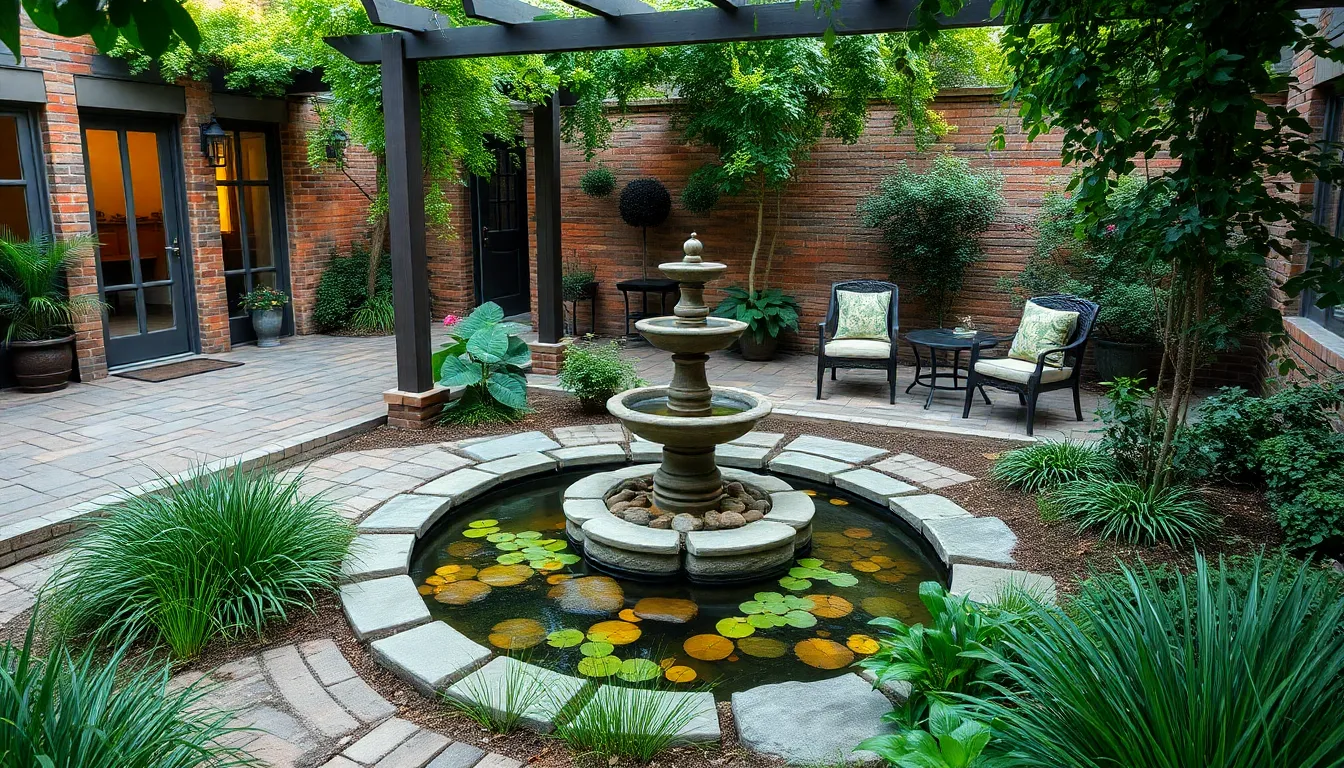
Building on your privacy foundation, we can transform the enclosed space into a welcoming courtyard that balances function with beauty. Creating this intimate garden environment requires careful attention to three key elements that work together seamlessly.
Select Appropriate Paving Materials
Brick pavers create timeless elegance while offering excellent durability for high-traffic areas. We recommend choosing materials that can withstand various weather conditions without compromising their visual appeal throughout the seasons.
Stone surfaces provide natural beauty with options including flagstone, bluestone, and limestone that complement any garden style. These materials offer slip-resistant textures that make walking safe even when wet from morning dew or rain.
Concrete pavers deliver modern versatility with countless color and pattern options that fit contemporary design schemes. They’re cost-effective answers that provide smooth surfaces for furniture placement and easy maintenance over time.
Permeable materials support drainage by allowing water to filter through rather than creating puddles or runoff issues. Options like permeable concrete, gravel, or spaced stone pavers help manage water naturally while maintaining clean, dry pathways.
Install Central Water Features
Small ponds become focal points that draw the eye inward and create a sense of tranquility within your enclosed space. We suggest incorporating aquatic plants like water lilies or cattails to enhance the natural network and attract beneficial wildlife.
Fountain installations add soothing sounds that mask neighborhood noise while creating a peaceful atmosphere for relaxation. Tiered fountains, wall-mounted spouts, or simple bubbling features work well in courtyard settings without overwhelming the space.
Wildlife attraction increases when we include shallow water sources that birds and butterflies can access safely. Small birdbaths or shallow pond edges provide drinking spots that bring life and movement to your garden sanctuary.
Water circulation systems maintain healthy water quality while preventing stagnation and mosquito breeding. Solar-powered pumps offer eco-friendly operation that keeps water moving without increasing electricity costs.
Arrange Seating Areas Strategically
Shaded locations maximize comfort by positioning chairs, benches, or built-in seating under pergolas, large plants, or near structures that block harsh sunlight. We prioritize spots that receive morning sun but afternoon shade for optimal relaxation timing.
Proximity to water features enhances the sensory experience by combining visual beauty with calming sounds. Placing seating within 6-8 feet of fountains or ponds creates an immersive environment without overwhelming conversation.
Multiple seating zones accommodate different activities and group sizes throughout your courtyard space. Consider including intimate two-person spots alongside larger gathering areas for entertaining friends and family.
Weather protection ensures year-round usability through covered areas, windbreaks, or moveable umbrellas that adapt to changing conditions. Strategic placement near walls or under overhangs extends the outdoor season significantly.
Build a Greenhouse Garden Room
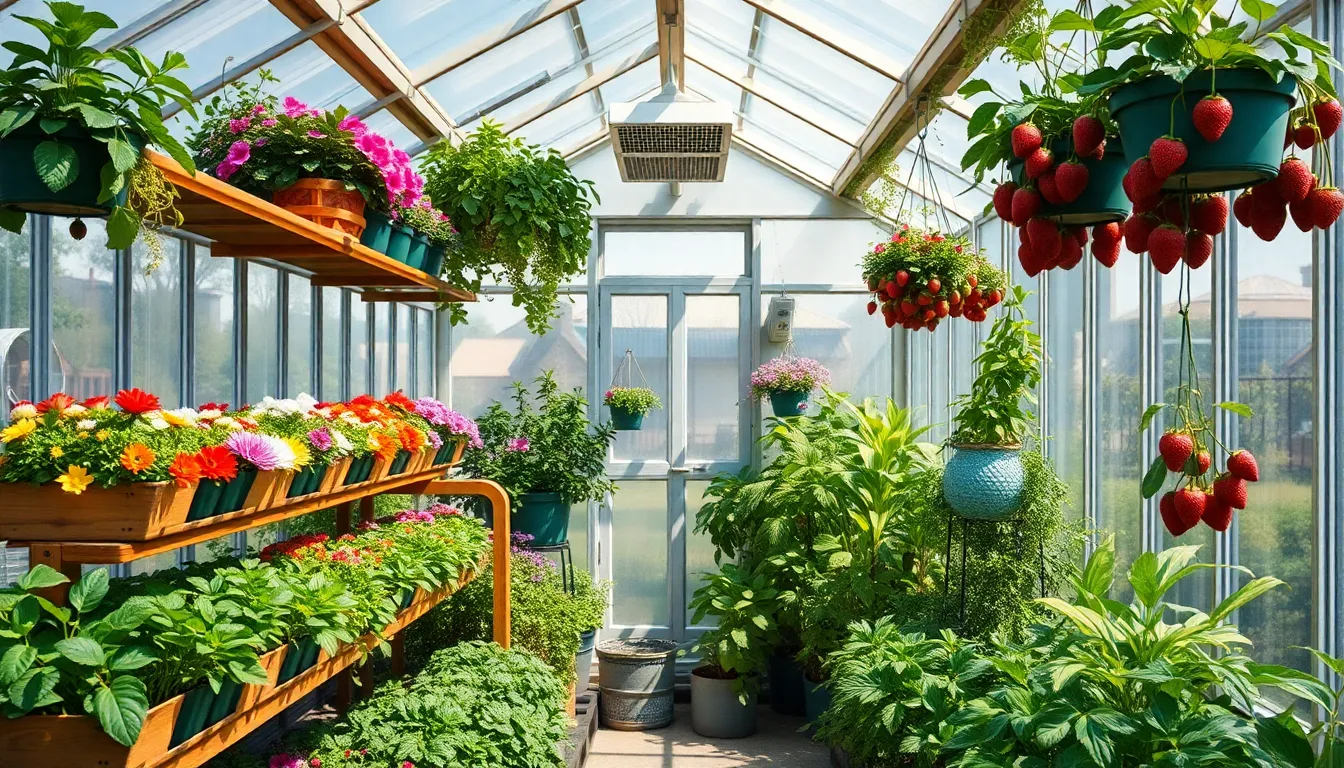
Creating a greenhouse transforms your enclosed garden into a year-round sanctuary where you can nurture plants regardless of outdoor weather conditions. We’ll explore the essential decisions that make your greenhouse both functional and beautiful.
Consider Glass vs Polycarbonate Options
Glass panels offer superior aesthetic appeal and crystal-clear transparency that maximizes natural sunlight penetration into your growing space. We recommend glass for gardeners who prioritize visual clarity and don’t mind investing in premium materials, though the added weight requires stronger structural support.
Polycarbonate panels provide excellent value through their lightweight construction and superior insulation properties that help maintain consistent temperatures. We find these panels particularly beneficial for beginning greenhouse gardeners since they’re more affordable and offer built-in UV protection that prevents harmful rays from damaging sensitive plants.
Budget considerations often favor polycarbonate, while aesthetic preferences lean toward glass, so we suggest evaluating your priorities before making this crucial material decision.
Plan for Proper Ventilation Systems
Automatic vent openers eliminate guesswork by responding to temperature changes without requiring your constant attention throughout the day. We install these temperature-controlled systems to prevent overheating during warm periods and maintain optimal humidity levels that support healthy plant growth.
Airflow management becomes critical for removing excess moisture that can lead to fungal problems and plant diseases in your enclosed environment. We position intake vents near ground level and exhaust vents at the roof peak to create natural convection currents that circulate fresh air continuously.
Strategic vent placement ensures your plants receive adequate air circulation while maintaining the controlled environment that makes greenhouse growing so effective.
Organize Growing Spaces Efficiently
Vertical gardening maximizes your available square footage by utilizing wall space with shelving systems and trellises that accommodate climbing plants and stacked containers. We arrange growing areas in tiers that allow shorter plants on lower shelves while taller specimens occupy floor space or upper supports.
Raised beds enhance soil drainage and provide comfortable working heights that reduce back strain during planting and maintenance activities. We construct these elevated growing areas using cedar or composite materials that resist moisture damage while creating defined spaces for different plant varieties.
Hanging baskets add decorative appeal while creating additional growing capacity for trailing plants like strawberries, herbs, and flowering varieties that thrive in suspended containers. We position these baskets at varying heights to create visual interest while ensuring adequate light reaches all your plants.
Construct a Pergola-Covered Garden Retreat
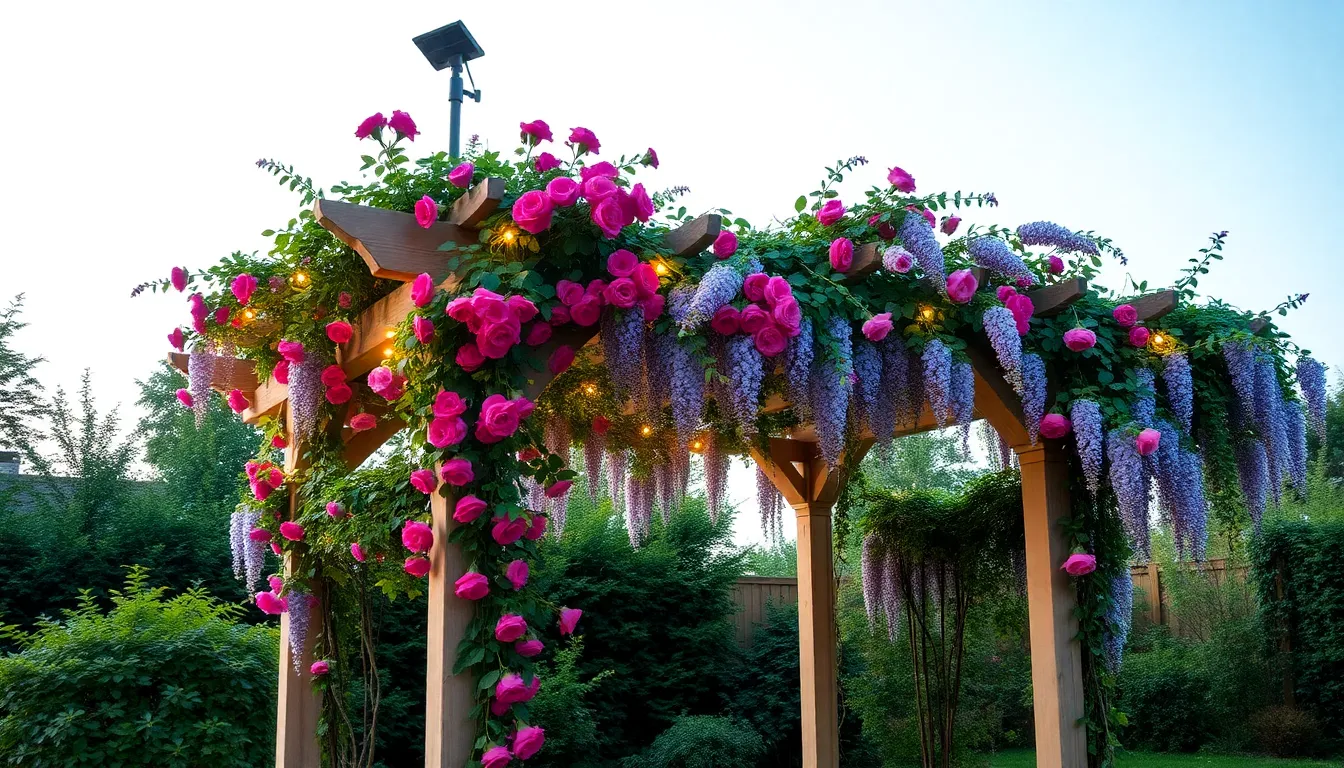
Building on our enclosed garden foundation, we can create an elegant overhead structure that provides both shelter and stunning visual appeal. Pergolas offer the perfect balance of openness and protection while supporting beautiful climbing plants.
Select Durable Framework Materials
Cedar and teak wood deliver exceptional durability with natural weather resistance that’ll last for decades. These premium materials develop a beautiful patina over time while maintaining their structural integrity against harsh weather conditions.
Aluminum frameworks provide superior strength with minimal maintenance requirements. We recommend this metal option for its lightweight properties and resistance to rust, making it ideal for regions with heavy rainfall or coastal environments.
Steel structures offer maximum stability for larger pergola designs. This robust material can support heavier loads including extensive vine coverage and additional features like hanging planters or outdoor curtains.
Recycled plastic lumber presents an eco-friendly alternative that mimics wood’s appearance without the upkeep. This sustainable option resists insects, rot, and fading while contributing to environmental conservation efforts.
Choose Climbing Vines and Plants
Roses create spectacular floral displays with their fragrant blooms throughout the growing season. We suggest selecting climbing varieties like ‘New Dawn’ or ‘Eden’ that produce continuous flowers and adapt well to pergola structures.
Wisteria offers dramatic cascading flowers in purple, pink, or white clusters. This vigorous climber requires annual pruning but rewards us with breathtaking spring displays that transform any pergola into a fairytale setting.
Clematis varieties provide diverse flowering options from delicate pastels to bold purples. These versatile climbers bloom at different times, allowing us to create extended seasonal interest with careful variety selection.
Grapevines combine beauty with productivity by offering edible harvests alongside attractive foliage. We can enjoy fresh grapes while benefiting from the natural shade these vigorous climbers provide during summer months.
Kiwi plants deliver unique heart-shaped leaves with the bonus of nutritious fruit. These hardy climbers require both male and female plants for fruit production but create excellent privacy screening year-round.
Integrate Outdoor Lighting Answers
Solar-powered string lights create magical ambiance without requiring electrical installation. We can drape these energy-efficient lights across pergola beams to establish a warm, inviting atmosphere for evening gatherings.
LED pathway lighting ensures safe navigation while highlighting garden features below the pergola. These low-voltage options consume minimal energy while providing consistent illumination for walkways and planting areas.
Solar-powered lanterns mounted on pergola posts deliver focused lighting for dining or reading areas. We recommend choosing models with adjustable brightness settings to customize the lighting intensity based on activities.
Recessed LED strips installed along pergola beams create subtle architectural lighting. This integrated approach provides even illumination while maintaining clean lines and preventing glare that might disturb nighttime relaxation.
Install Living Wall Boundaries
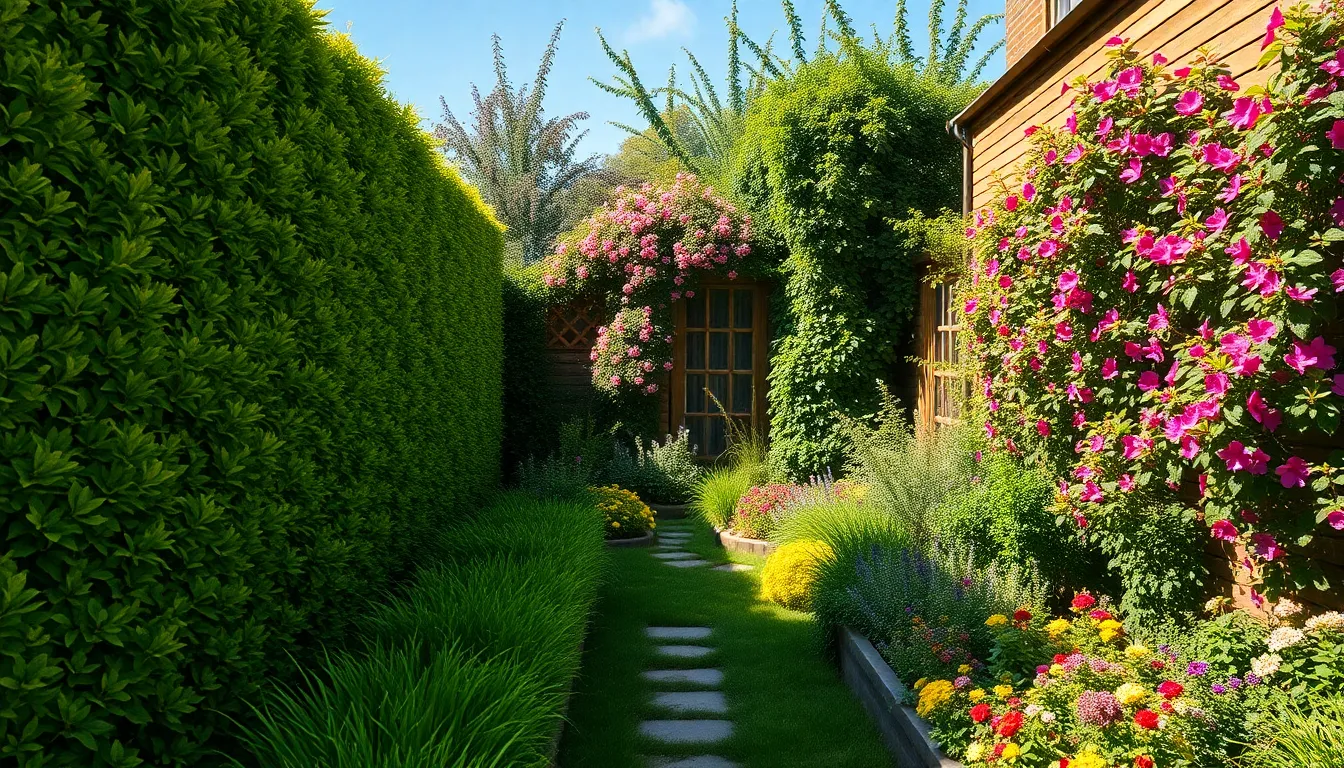
Living boundaries transform enclosed gardens into intimate sanctuaries while providing essential privacy and wind protection. We’ll explore how to create natural walls that enhance your garden’s microclimate and visual appeal.
Choose Suitable Plant Varieties
Hedge plants create dense, natural boundaries that offer year-round privacy. We recommend evergreen options like boxwood, privet, or yew for consistent coverage, while deciduous varieties such as hornbeam provide seasonal interest. Fast-growing species including bamboo clumping varieties, laurel, and photinia establish boundaries quickly within 2-3 growing seasons.
Espaliered trees maximize vertical space while creating structured living walls. We suggest training apple, pear, or citrus trees against walls or trellises for both beauty and harvest potential. Climbing plants transform basic structures into lush boundaries through varieties like:
- English ivy for dense, evergreen coverage
- Climbing roses for seasonal blooms and fragrance
- Clematis for colorful vertical displays
- Virginia creeper for rapid autumn color
Edible options combine functionality with natural enclosure through grapevines, kiwi plants, or climbing beans. We choose these varieties based on local climate zones and available sunlight exposure to ensure successful establishment.
Set Up Irrigation Systems
Drip irrigation systems deliver water efficiently to living wall plants while minimizing waste and disease risk. We install emitter lines along hedge bases or climbing plant roots to provide consistent moisture without overhead watering. Automated timers ensure regular watering schedules, particularly crucial for newly planted boundaries that need establishment support.
Soaker hoses work effectively for linear plantings like hedge rows, delivering slow, deep watering directly to root zones. We position these systems 2-3 inches from plant bases to encourage proper root development. Micro-spray systems benefit larger espaliered trees or climbing structures where broader coverage helps maintain consistent soil moisture.
Drainage answers prevent waterlogged conditions that damage living wall plants. We incorporate gravel bases or French drains for areas with poor natural drainage, especially important for raised planting beds along walls or fences.
Maintain Proper Growing Conditions
Soil preparation ensures healthy root development for boundary plants through regular testing and amendment. We maintain pH levels between 6.0-7.0 for most hedge and climbing varieties while adding organic compost annually to improve soil structure and nutrient content.
Light management maximizes growing success by ensuring 6-8 hours of daily sunlight for most living wall plants. We use shade cloth during extreme heat or install reflective panels to redirect light in shadowy areas. Pruning schedules maintain desired shapes and encourage dense growth through seasonal trimming of hedges and training of climbing plants.
Pest monitoring protects living boundaries from damage through regular inspection and preventive measures. We install physical barriers like copper strips for slugs or beneficial insect houses to encourage natural pest control. Mulching practices retain soil moisture and suppress weeds around boundary plantings using organic materials like shredded bark or compost.
Seasonal care maintains year-round boundary health through appropriate fertilization, winter protection, and spring renewal activities that keep living walls thriving and effective.
Create a Sunken Garden Design
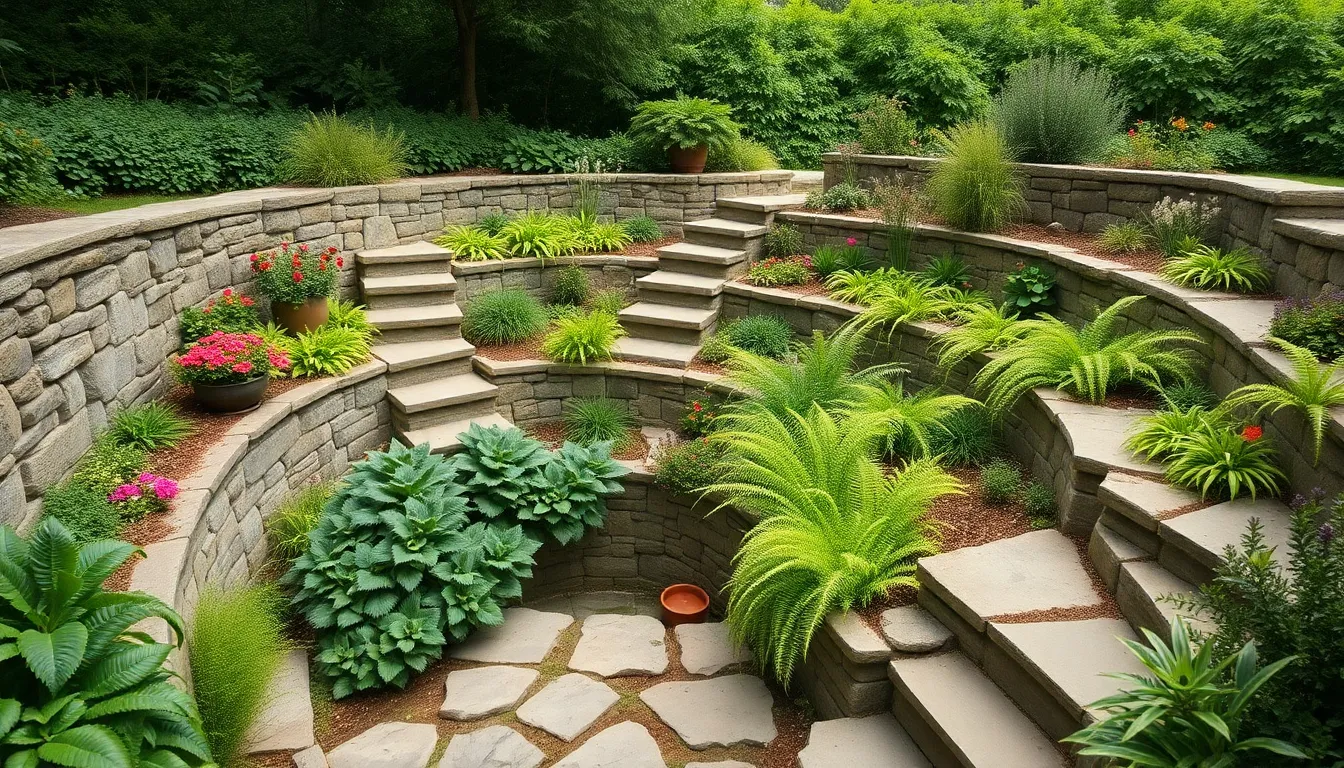
A sunken garden brings your enclosed space to new depths, literally creating an intimate retreat below ground level. We’ll guide you through transforming your enclosed garden into this captivating industry feature that adds dimension and intrigue to any outdoor sanctuary.
Plan Excavation and Drainage
Excavation planning sets the foundation for your sunken garden’s success. We recommend determining the depth and size based on your available space and desired water features, as this crucial step impacts every subsequent decision. Most sunken gardens work best at depths ranging from 18 inches to 4 feet, depending on your exact design goals.
Drainage systems prevent water accumulation that can lead to soggy soil and plant damage. We suggest installing French drains or gravel drainage layers at the bottom of your excavated area to ensure proper water flow. Installing perforated pipes surrounded by gravel creates an effective drainage network that channels excess water away from your sunken garden. Adding a waterproof membrane helps direct water to designated drainage points while protecting surrounding structures.
Build Retaining Wall Structures
Stone retaining walls provide the structural support your sunken garden needs while adding natural beauty. We recommend using materials like limestone, sandstone, or granite blocks that complement your existing enclosed garden aesthetic. These durable options withstand soil pressure while creating attractive boundaries for your sunken space.
Brick structures offer another excellent choice for retaining walls, especially when they match your home’s architecture. We suggest selecting weather resistant brick varieties that handle moisture exposure without deteriorating over time. Creating proper footings with concrete foundations ensures your brick walls remain stable and structurally sound for years.
Concrete retaining walls deliver maximum durability for larger sunken garden projects. We recommend reinforced concrete construction when dealing with important soil loads or deeper excavations. Adding decorative finishes like stone veneer or stucco transforms utilitarian concrete walls into attractive garden features that enhance your enclosed space’s overall appeal.
Design Stepped Planting Areas
Tiered planting beds maximize your sunken garden’s growing space while creating visual interest at multiple levels. We suggest building terraced sections using the same materials as your retaining walls to maintain design consistency. Creating beds at varying heights allows you to showcase different plant types while ensuring proper drainage throughout each level.
Plant selection for sunken environments requires choosing species that thrive in moist, partially shaded conditions. We recommend ferns, hostas, and astilbe for shaded areas, while incorporating moisture loving perennials like cardinal flower and joe pye weed in sunnier spots. Adding bog plants like iris and cattails creates authentic wetland ecosystems that require minimal maintenance once established.
Stepped pathways connect your planting areas while providing safe access throughout the sunken garden. We suggest using natural stone steps or timber risers that complement your retaining wall materials. Installing handrails along steeper sections ensures safety while maintaining the garden’s intimate enclosed feeling that makes sunken designs so appealing.
Establish a Walled Herb Garden
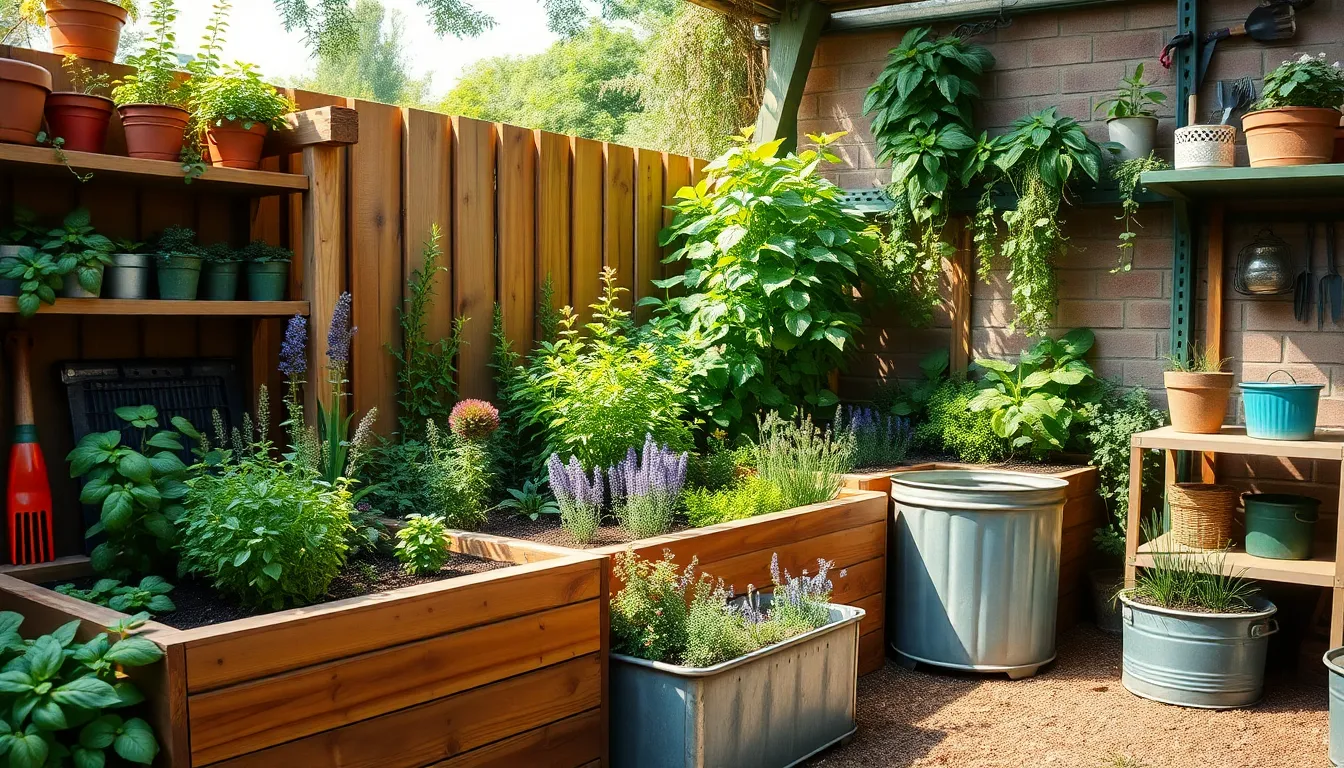
Transforming your enclosed garden into a walled herb sanctuary creates the perfect blend of privacy and productivity. This dedicated space allows us to cultivate aromatic plants while maintaining the intimate atmosphere we’ve established with our garden boundaries.
Select Aromatic Plant Combinations
Combining herbs with complementary flowering plants maximizes both fragrance and visual appeal in our enclosed space. Pairing herbs like basil, rosemary, and thyme with lavender and roses creates layers of scent that enhance the garden’s sensory experience throughout the seasons.
Establishing aromatic hedges using rosemary or lavender provides natural borders while contributing to the overall fragrance profile. These plants serve dual purposes as they define growing areas and release pleasant scents when brushed against during garden maintenance.
Creating themed herb clusters allows us to group plants with similar growing requirements while building aromatic zones. Mediterranean combinations like oregano, sage, and rosemary thrive together, while mint varieties can be contained in separate sections to prevent spreading.
Install Raised Growing Beds
Building raised beds with 2.5 feet depth ensures comfortable reach while providing optimal growing conditions for herb cultivation. This accessibility factor becomes crucial when we’re harvesting daily ingredients or performing routine garden maintenance tasks.
Selecting durable materials like cedar wood or galvanized metal creates long lasting structures that complement our enclosed garden’s aesthetic. Wood frames offer natural warmth, while metal options provide clean, modern lines that work well with contemporary garden designs.
Filling beds with quality soil and compost mixtures establishes the foundation for healthy herb growth. We can customize soil blends for exact herb requirements, ensuring plants like Mediterranean herbs receive well draining conditions while moisture loving varieties get appropriate growing mediums.
Add Functional Storage Answers
Installing shelving units and storage cabinets near growing beds keeps essential tools and supplies within easy reach. These organizational elements help maintain the garden’s functionality while preserving the enclosed space’s clean, purposeful appearance.
Setting up dedicated watering stations or installing irrigation systems ensures consistent plant care without disrupting the garden’s layout. Convenient water access allows us to maintain proper moisture levels for different herb varieties without carrying supplies across the entire enclosed area.
Incorporating seed storage and potting areas creates designated spaces for garden expansion and seasonal planting activities. These functional zones support ongoing cultivation while keeping supplies organized and protected from weather elements within our enclosed herb garden sanctuary.
Design a Japanese-Inspired Enclosed Space
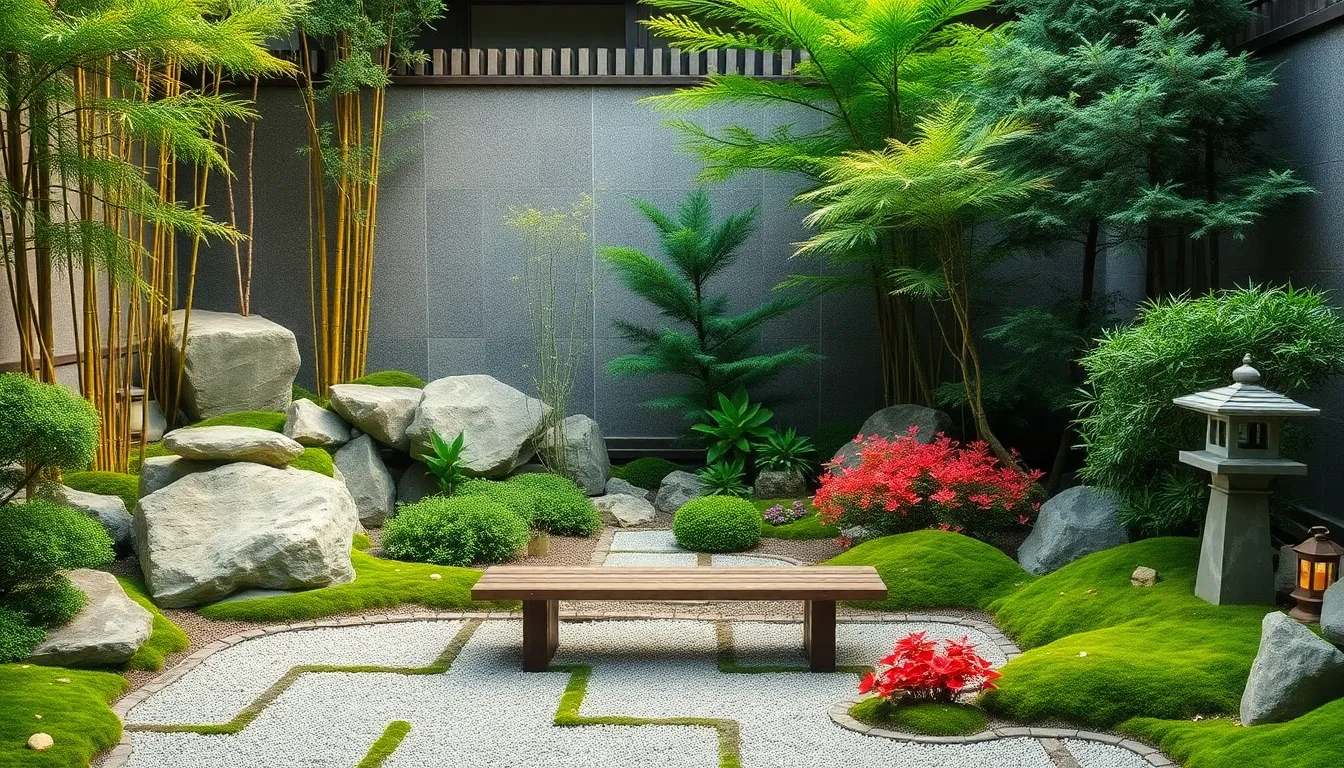
Transform your enclosed garden into a serene sanctuary that reflects centuries-old Japanese design principles. Creating an authentic Japanese-inspired space requires careful attention to natural elements, thoughtful plant selection, and purposeful meditation areas.
Incorporate Traditional Elements
Vertical features establish the foundation of your Japanese garden design through strategic placement of rocks, bamboo, and carefully selected trees. Position these elements asymmetrically to create visual balance while maintaining the natural, minimalist aesthetic that defines authentic Japanese gardens. Stone arrangements serve as anchor points that provide height and structure throughout your enclosed space.
Horizontal elements complement vertical features by introducing raked gravel areas and stone gardens that symbolize water or distant landscapes. These ground level features create the illusion of flowing streams or calm lakes without requiring actual water installation. Wood, stone, and bamboo materials work best for constructing fences or gates that enclose your space while maintaining privacy and discovery.
Asymmetrical groupings of rocks and plants follow traditional Japanese design principles that emphasize natural randomness over formal symmetry. Arrange elements in odd numbered clusters that feel organic rather than planned. Low fences, bamboo screens, and strategic hedges create enclosure while incorporating borrowed scenery from surrounding areas.
Choose Complementary Plant Species
Evergreen foundations provide year-round structure through Japanese maple, green bamboo, and pine varieties that maintain their presence across all seasons. These plants create the backbone of your garden design while offering consistent visual anchors. Select species that naturally complement each other in terms of growth patterns and seasonal changes.
Seasonal accent plants mark the passage of time through evergreen azaleas and flowering varieties that bloom at different points throughout the year. These plants add subtle color variations without overwhelming the minimalist aesthetic. Choose varieties that offer gentle transitions between seasons rather than dramatic color bursts.
Ground coverage options include moss applications around rocks and pathways that create soft, natural carpeting effects. Moss thrives in partially shaded areas and requires minimal maintenance once established. Apply moss selectively to enhance the aged, weathered appearance that characterizes authentic Japanese gardens.
Create Peaceful Meditation Areas
Strategic seating placement positions benches near water features, beneath established trees, or facing carefully composed garden views. Simple wooden platforms or low benches provide comfortable resting spots without disrupting the natural flow of your space. Choose seating materials that weather naturally and blend with surrounding elements.
Zen rock gardens serve as meditative focal points through raked gravel patterns that encourage mindful contemplation. Create these areas in quiet corners of your enclosed space where visitors can sit peacefully and reflect. Maintain clean, simple patterns that invite mental focus rather than distraction.
Mindfulness features enhance the contemplative atmosphere through stone lanterns and water basins that encourage ritual and reflection. Small bridges and stepping stones guide movement through your space while creating opportunities for pause and observation. Keep architectural elements minimal and natural to maintain focus on the industry rather than decorative objects.
Build a Cottage Garden With Picket Fencing
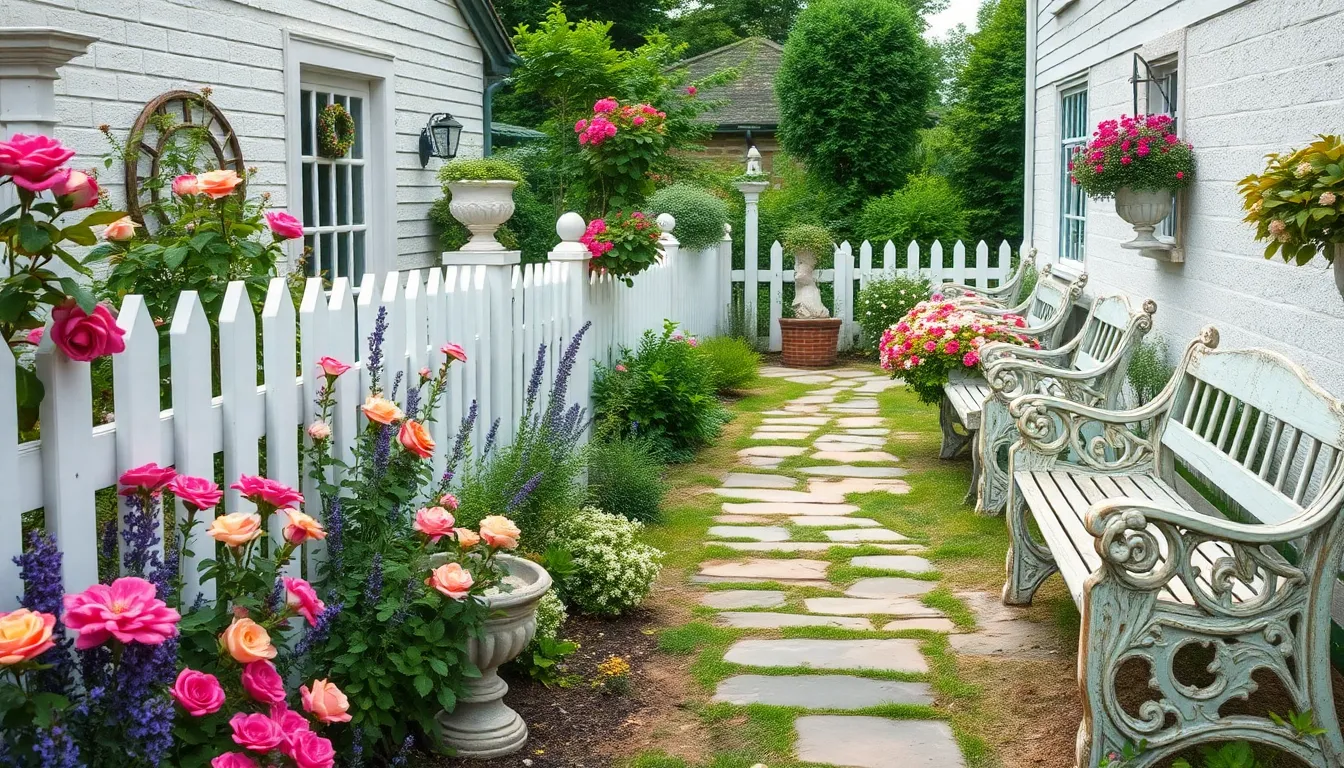
Picket fencing transforms our enclosed garden into a charming cottage sanctuary that perfectly balances privacy with welcoming appeal. We’ll create this timeless look by combining classic white or colored picket panels with carefully chosen plants and decorative elements that enhance the romantic garden atmosphere.
Select Colorful Flowering Plants
Mix annuals and perennials to ensure our cottage garden displays vibrant colors throughout every growing season. Roses, lavender, and sunflowers provide the foundation for our colorful displays, while annual flowers like zinnias, marigolds, and cosmos fill gaps between established plantings.
Plant climbing varieties along our picket fence to maximize vertical space and create natural privacy screens. Clematis and climbing roses train beautifully against picket panels, while morning glories and sweet peas add seasonal color and fragrance to fence sections.
Design flower borders with varying heights to create depth and visual interest throughout our cottage garden space. Tall delphiniums and hollyhocks anchor back borders, medium-height plants like peonies and daylilies fill middle sections, and low-growing alyssum and lobelia edge pathways with continuous blooms.
Create Winding Pathway Designs
Choose natural materials like stone, brick, or gravel to establish pathways that complement our cottage garden’s rustic charm. Flagstone provides durability and natural beauty, while brick offers classic appeal that ages gracefully, and crushed gravel creates affordable pathways that drain effectively after rainfall.
Design curved walkways that encourage exploration and discovery throughout our enclosed garden space. Gentle curves feel more natural than straight lines, while meandering paths create opportunities for surprise plantings and hidden seating areas that enhance our garden’s cottage appeal.
Edge pathways strategically with low-growing plants and decorative borders that define walking areas without overwhelming the cottage aesthetic. Boxwood hedging provides formal structure, while informal plantings of catmint and lamb’s ear create soft, touchable borders that invite interaction with our garden space.
Add Vintage Garden Accessories
Incorporate antique elements like weathered statues, vintage benches, and aged planters to establish authentic cottage garden character. Old watering cans serve as charming planters, while antique garden tools mounted on fence sections create functional wall art that celebrates gardening heritage.
Position focal points strategically throughout our cottage garden to draw attention and create visual anchors between planted areas. Vintage birdhouses attract beneficial wildlife, while old-fashioned garden gates provide charming entrances to different garden rooms, and weathered sundials serve as timeless centerpieces for herb or flower circles.
Select accessories thoughtfully to avoid cluttering our cottage garden while maintaining authentic vintage appeal. Galvanized metal containers work perfectly for herb plantings, while old wooden wheelbarrows create mobile garden displays, and vintage garden signs add personality without overwhelming our carefully planned plant combinations.
Conclusion
Creating your perfect enclosed garden sanctuary becomes achievable when you understand the diverse options available. Whether you’re drawn to the modern elegance of pergola retreats or the timeless charm of cottage gardens with picket fencing each design approach offers unique benefits for your outdoor space.
We’ve explored answers that work for every budget and skill level from simple privacy screens to elaborate sunken garden designs. The key lies in selecting elements that match your lifestyle and maintenance preferences while creating the private oasis you’ve always envisioned.
Your enclosed garden journey starts with a single step. Choose the design elements that resonate most with your vision and begin transforming your outdoor space into the peaceful retreat you deserve.
Frequently Asked Questions
What materials are best for creating garden privacy screens?
The best materials for garden privacy screens include composite, cedar, vinyl, and aluminum. These weather-resistant options offer durability and low maintenance. Cedar provides natural beauty, vinyl requires minimal upkeep, aluminum offers modern aesthetics, and composite combines durability with style. Choose based on your climate, budget, and design preferences.
How can I add visual interest to plain fence panels?
Enhance plain fence panels with decorative elements like geometric cutouts, horizontal slat designs, and mixed material combinations. You can also incorporate climbing plants such as roses, clematis, or evergreen vines to add natural beauty and soften hard lines while maintaining privacy.
What are the fastest-growing plants for garden privacy?
Fast-growing privacy plants include bamboo, privet, Leyland cypress, and climbing vines like Virginia creeper. These options can quickly establish coverage within 1-2 growing seasons. Bamboo provides instant screening, while evergreen options like Leyland cypress offer year-round privacy and can grow 3-4 feet annually.
Should I choose glass or polycarbonate for a greenhouse garden room?
Glass offers superior aesthetics and light transmission but costs more and requires careful handling. Polycarbonate is more affordable, provides better insulation, and is virtually unbreakable. For budget-conscious gardeners, polycarbonate is ideal, while glass suits those prioritizing appearance and maximum light for plant growth.
What’s the best paving material for a courtyard garden?
Brick pavers, natural stone, and concrete pavers are excellent courtyard options. Brick offers classic charm and durability, natural stone provides elegance and unique character, while concrete pavers are versatile and budget-friendly. Choose permeable materials for proper drainage and consider your climate and maintenance preferences.
How do I prevent water problems in a sunken garden?
Install proper drainage systems including French drains, gravel layers, and drainage pipes before excavation. Ensure the lowest point has adequate water exit routes. Use retaining walls with weep holes, and select plants that tolerate moisture. Regular maintenance of drainage systems prevents water accumulation and structural damage.
What herbs work best together in an enclosed garden?
Combine aromatic herbs like basil, rosemary, and thyme with complementary flowering plants such as lavender and chamomile. Group Mediterranean herbs together as they share similar water and sun requirements. Create themed clusters like culinary herbs, tea herbs, or medicinal herbs for both functionality and visual appeal.
How can I create a Japanese-inspired garden design?
Focus on asymmetrical rock arrangements, raked gravel areas, and minimalist plant selections. Use evergreens like pine and bamboo, incorporate low fencing, and create meditation spaces with strategic seating. Add water features like small fountains and maintain clean lines with careful pruning and thoughtful plant placement.

